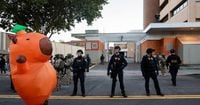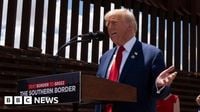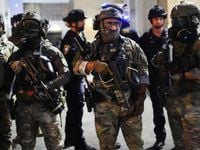President Donald Trump’s recent threat to invoke the Insurrection Act—a rarely used, centuries-old law—has set off a political firestorm and legal scramble across the United States. On October 7, 2025, Trump told reporters, “We have an Insurrection Act for a reason,” making it clear he was considering deploying federal troops to American cities, particularly those led by Democratic officials, to enforce immigration laws and restore order. The statement, delivered from the Oval Office, echoed a week of escalating rhetoric and military maneuvers that have left state leaders, legal scholars, and citizens alike wondering just how far presidential power can reach in the name of public safety and federal authority.
At the heart of the controversy is Chicago, a city Trump described as a “great city where there’s a lot of crime.” He continued, “And if the governor can’t do the job, we’ll do the job. It’s all very simple.” According to ABC News, approximately 200 National Guard troops from Texas were preparing to deploy to Chicago, a move that Illinois Democratic Governor JB Pritzker blasted as an “unconstitutional invasion of Illinois by the federal government.” Pritzker’s administration, along with city officials, quickly filed a lawsuit in the U.S. District Court, arguing that the deployment violated both state sovereignty and the Posse Comitatus Act, which forbids federal troops from conducting civilian law enforcement unless specifically authorized by Congress or the Constitution.
The Insurrection Act, signed into law in 1807 by President Thomas Jefferson, grants the president the extraordinary authority to use military force within the United States to quell “insurrection” or enforce federal laws when local authorities are unable or unwilling to do so. As Axios notes, the law has not been “meaningfully updated” in over 150 years, and legal experts warn it gives the president “limitless discretion to deploy the military domestically.” The last time it was invoked without a governor’s consent was in 1965 by President Lyndon Johnson to protect civil rights activists in Alabama. More recently, it was used in 1992 by President George H.W. Bush, at California’s request, during the Los Angeles riots.
Trump’s threat is not limited to Illinois. He has also targeted Portland, Oregon, where protests against immigration enforcement erupted near an Immigration and Customs Enforcement (ICE) building on October 4, 2025. The clashes, which resulted in at least two arrests, were cited by Trump as evidence of “criminal insurrection.” However, Democratic Oregon Governor Tina Kotek flatly rejected the claim, telling Al Jazeera, “There is no insurrection in Portland. No threat to national security.” Legal scholars echoed her sentiment. Bruce Fein, a constitutional lawyer, told Al Jazeera, “No underanged person believes a rebellion is under way in Portland.”
Despite the lack of widespread violence or collapse of civil order, Trump insisted that he would invoke the Act if “people were being killed and courts were holding us up, or governors or mayors were holding us up.” He added, “If I had to enact it, I do. If people were being killed, and courts were holding us up, or governors or mayors were holding us up, sure I’d do that.” These statements have alarmed not only Democratic leaders but also nonpartisan policy institutes. The Brennan Center for Justice, cited by Axios, warns that the Act’s vague language—failing to define terms like “insurrection,” “rebellion,” or “domestic violence”—leaves the door wide open for executive overreach.
Legal pushback has already begun. In Oregon, a federal judge temporarily blocked Trump’s attempt to deploy National Guard troops to Portland, with the block set to last until October 18, 2025. California Governor Gavin Newsom, whose state also saw deployments, called Trump’s use of Title 10 authority—a separate federal law allowing the president to deploy the National Guard without a governor’s approval—a “breathtaking abuse of the law and power.” According to Al Jazeera, Newsom vowed, “We will take this fight to court, but the public cannot stay silent in the face of such reckless and authoritarian conduct by the president of the United States.”
Meanwhile, in Washington, D.C., National Guard members were seen patrolling the National Mall on October 1, 2025, a visible sign that Trump’s deployment strategy was already in motion. The president’s allies, including Texas Republican Governor Greg Abbott and senior adviser Stephen Miller, have amplified the message. Abbott told Fox News, “We have local states refusing to enforce the law, and we have chaos.” Miller went further in a CNN interview, declaring, “There is an effort to delegitimize the core function of the federal government of enforcing our immigration laws and our sovereignty. It is domestic terrorism. It is insurrection.”
The legal and political stakes are enormous. The Brennan Center points out that while the Supreme Court in 1827 ruled that the authority to decide whether exigent circumstances exist is “exclusively vested in the President,” more recent opinions suggest courts could intervene if the president acts in bad faith or makes a clear mistake. Georgetown law professor Steve Vladeck, writing in The New York Times, posed the central question: “Can the courts meaningfully scrutinize the president’s claims, or must they blindly defer?”
For Illinois and Chicago, the immediate concern is the presence of hundreds of out-of-state troops in their streets. The lawsuit filed by state and city officials accuses the Trump administration of violating the Posse Comitatus Act and exceeding its authority. As of October 7, 2025, a court hearing was scheduled to address the legality of the deployment. Governor Pritzker, speaking at a press conference, accused Trump of “following a playbook—cause chaos, create fear and confusion, make it seem like peaceful protesters are a mob by firing gas pellets and tear gas canisters at night. Why? To create the pretext for invoking the Insurrection Act so that he can send military troops to our city.”
Experts warn that deploying the military in domestic law enforcement roles carries profound risks. Katherine Kuzminski, director of studies at the Center for a New American Security, told ABC News, “It creates a tinderbox. We are proud of the fact that we train the world’s most lethal fighting force. And that’s why we have such firm boundaries on their use in law enforcement.”
As the legal battles unfold and the country watches anxiously, one thing is clear: the debate over the Insurrection Act is about much more than the deployment of troops. It’s a test of the balance between federal and state power, the limits of executive authority, and the resilience of American democracy under stress.






